| Dates |
Sept. 24 – Oct. 11, 2025 Sept. 28 – Oct. 15, 2025 |
| Duration | 17 nights, 16 days. Each pilgrimage has the exact same itinerary. |
| Location | India: Delhi, Haridwar, Badrinath, Leh/Ladakh, and Rishikesh |
| Leaders | Four expert hosts from Ananda Spiritual Travels and Ananda Pilgrimages India |
In the high Himalayas lives a mystic spiritual power.
Why have saints from time immemorial sought out the Himalayas? Of incomparable natural beauty, they have been central to scriptures, myths, and legends of countless cultures and religions. Linked to Self-realized masters for thousands of years, these mountains embody spiritual aspiration and mankind’s highest potential.
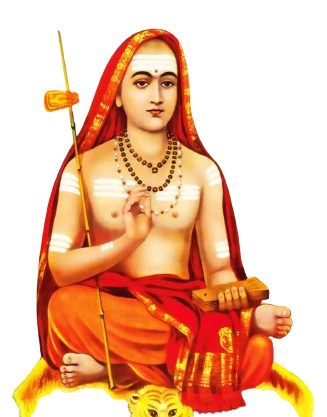
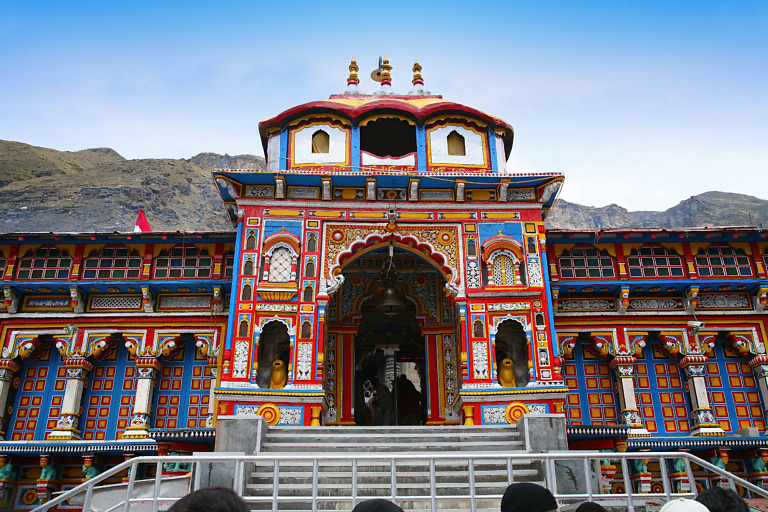
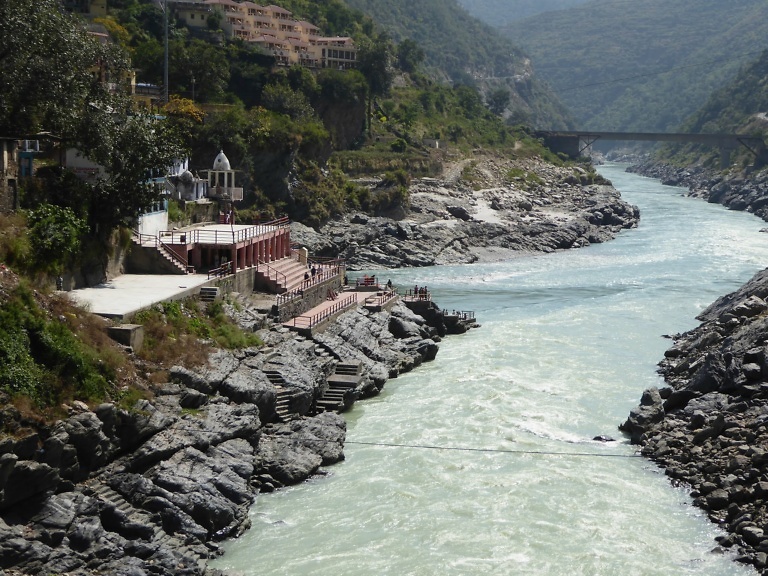
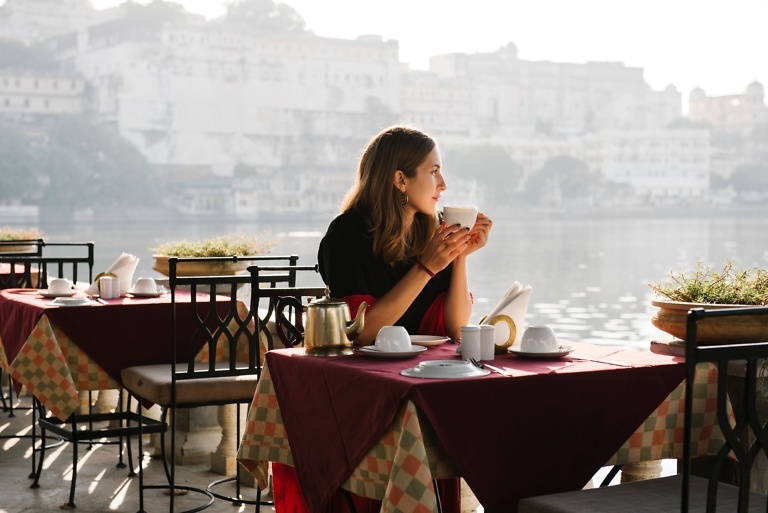
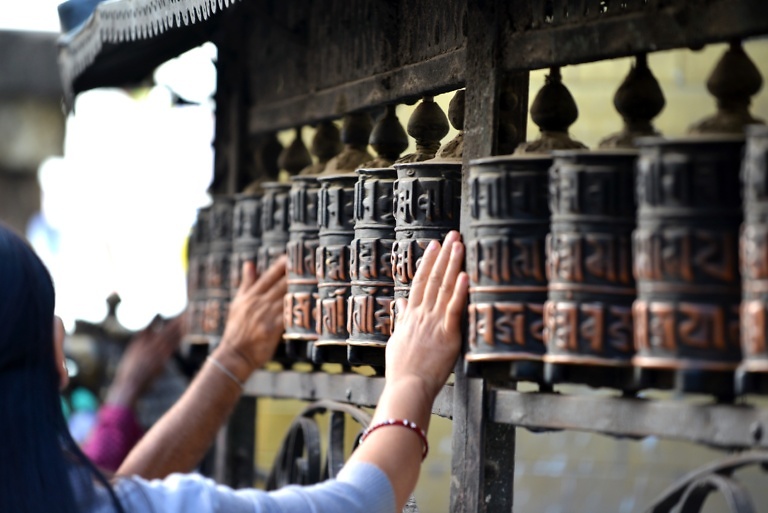
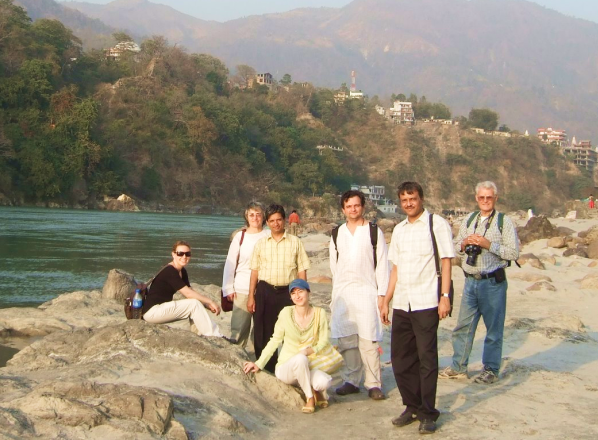






Explore and drink the nectar of some of the most sacred spiritual sites in India. Together we’ll ascend the extraordinary spiritual Himalayan heights.
This pilgrimage is for those who love nature, high mountains, and places of spiritual power—without needing to be a hiker or climber. Our trip in Northern India is timed for the best available weather conditions, and we’ll stay in comfortable places and enjoy delicious meals. Our seasoned Ananda Pilgrimage hosts are pleased to invite you to experience the exquisite beauty and spiritual power of the high Himalayas firsthand, as few people have.
High Himalayan Energy: Experience the extraordinary sights and vibrations of the high Himalayas – the beautiful, ancient cultures, and feel the spiritual power emanating from age-old sacred temples and monasteries
Ladakh, Badrinath, and Rishikesh — we’ll travel by plane and bus, not by days of trekking. Our journey will take us into the stark beauty of rugged mountains and remote spiritual destinations where we will visit monasteries, beautiful works of architecture, ancient art, caves, the powerful Ganges river, ashrams.
Connect with Higher Consciousness: Through divine friendship and connections within our own group, we’ll raise our energy through conscious practices, meditation, chanting, spiritual fellowship, and giving back to places of pilgrimage
Join us for experiences that last a lifetime.
Ladakh: To reach Ladakh we’ll fly directly over the Himalayas, one of the most beautiful flights in the world. Attune to the thousand years of continuous Tibetan Buddhist tradition, in the rarefied high desert beauty of Ladakh. Explore ancient monasteries in Ladakh, still standing untouched by foreign invasion, are beautiful works of architecture as well as power spots of spirituality.
With our Ladakhi Buddhist guide, we’ll visit and meditate in Tikse, Hemis, and Stakna monasteries—vibrant centers of meditation, dedication, and service, preserving a deep and ancient mystical heritage, still intact.
Badrinath: Badrinath is a spiritual destination of great power, even more ancient than India’s scriptures. It is considered the most important of the four sites in India’s Char Dham pilgrimage, and gets its name from the temple of Badrinath. It’s unlike anywhere else in the world. The rugged pure beauty of the mountains and rivers alone makes this an unforgettable trip.
We’ll visit the caves of Sri Adi Shankaracharya, founder of the ancient Swami order, and of Ved Vyasa, who scribed the Indian epic scripture, the Mahabharata, of which the Bhagavad Gita is the core.
Rishikesh: Rishikesh, land of the Rishis, is situated on the banks of the Ganges River. Saints and sages have frequented this sacred foothill locale for centuries. Hundreds of ashrams and yoga and meditation centers populate this fascinating and picturesque area.
Among the sacred places we will visit are the sites made holy by Swami Sivananda, other saints and ancient rishis. We’ll meditate along the banks of the Ganges, with time for walking and shopping.
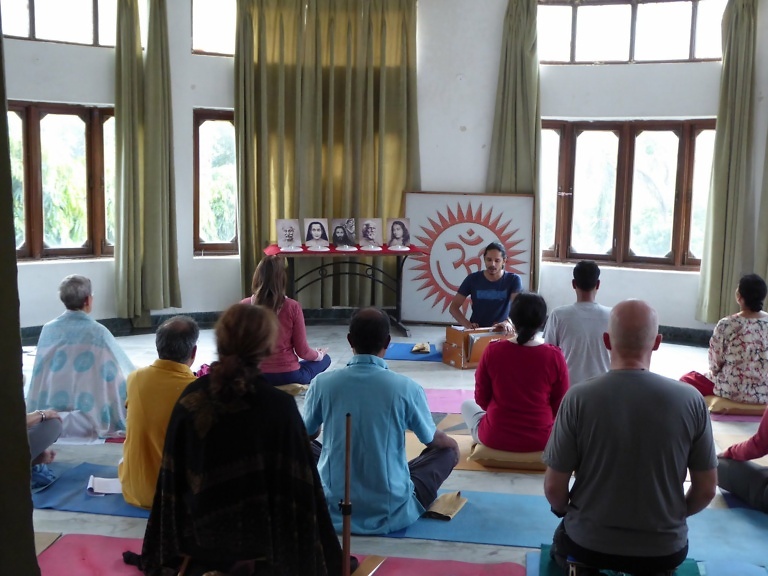
“I love Badrinath! There are no words to express what we experienced there both individually and as a group. For me it was a divine experience like never before.”
—R.B., registered guest
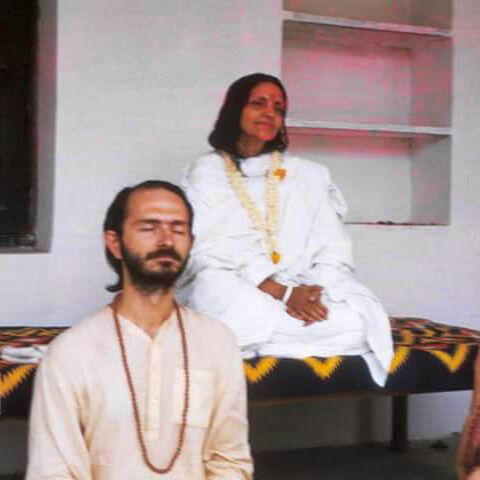
Haridwar: Anandamoyee Ma Ashram
“Who is it that loves and who that suffers? He alone stages a play with Himself; who exists save Him? The individual suffers because he perceives duality. It is duality which causes all sorrow and grief. Find the One everywhere and in everything and there will be an end to pain and suffering.”
—Anandamoyee Ma
In Haridwar, we will visit the shrine of Anandamoyee Ma, and take some time to meditate in this holiest of places where we can connect with her divine blessings.
Ma welcomed and conversed with devotees of different paths and religions from Shaivaite, Vaishnavite, Tantric, or from Islam, Christianity, Judaism, Sikhism, Buddhism, Zoroastrianism. Everyone was welcome and she was equally at ease while giving guidance to all practitioners of different faiths. She visited with Paramhansa Yogananda, and with his Disciple Swami Kriyananda, founder of Ananda.
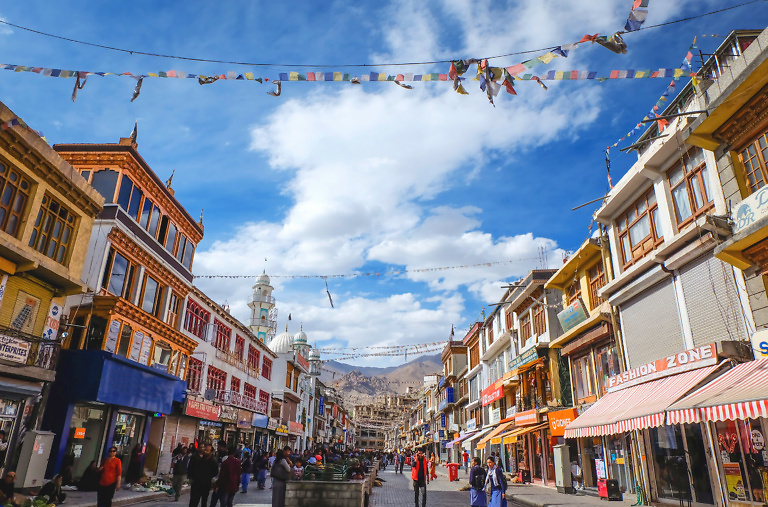
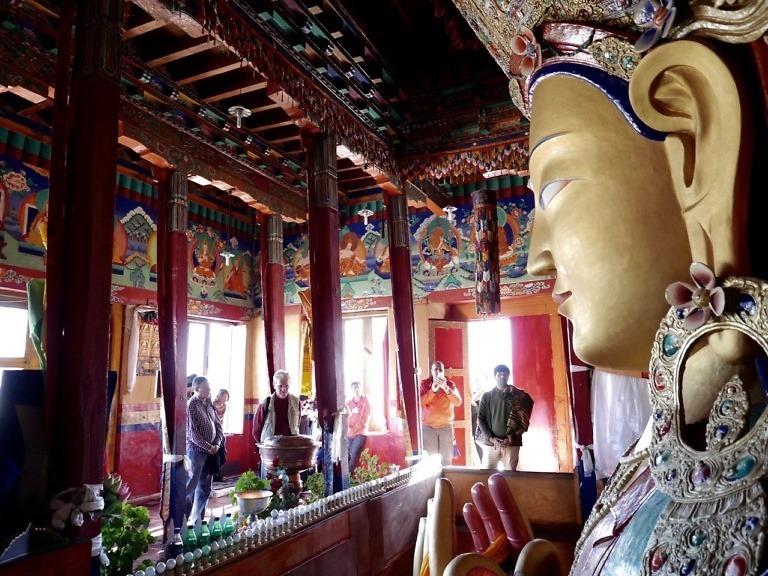
Buddhist Ladakh and Leh: Little Tibet
The environment of Ladakh, known as “Little Tibet,” is absolutely stunning. Rolling valley plains are surrounded by spectacular mountains. The remoteness of this area has a feeling of ageless power and grandiose splendor.
To reach Ladakh we’ll fly directly over the Himalayas, one of the most beautiful flights in the world. A well-kept global secret, Ladakh is part of the Tibetan plateau, and has remained a Shangri-La of traditional Buddhist heritage and culture. Only recently have foreigners been allowed to visit.
Our trip is timed for good weather conditions — much of the year Ladakh endures harsh cold weather. From our simple hotel in the Ladakh capital of Leh, we’ll take day trips to explore the Indus river valley, visiting and meditating in sacred hilltop monasteries and temples.
Ladakh is India’s most remote and sparsely populated region, a high desert, cradled by the Karakoram and the Himalayas. It offers a unique Himalayan landscape and culture that, until 1974, had been glimpsed by only a few intrepid Western travelers. It is one of the last undisturbed enclaves of Mahayana Buddhism, Ladakh’s principal religion for the last thousand years. Perched on rocky hilltops and sheer cliffs, medieval monasteries are both repositories of ancient wisdom and living centers of worship.
In the morning we’ll fly to Leh, the capital of Ladakh. It’s just a one-hour flight, but one of the most spectacular in the world—flying over the whole Himalayan range, from south to north, at an altitude low enough for incredible views.
After checking in to our hotel, (see below), we’ll rest for most of the day to acclimatize our bodies to the 11,500 foot elevation and the rarified air.
Mid-afternoon we’ll offer a visit to Shanti Stupa for a view over Leh, the meandering bright green Indus Valley, surrounding high desert, and lofty mountain peaks. We can then walk through a traditional village to reach Leh’s main bazaar, on the ancient Silk Road connecting China, India, and Europe. It’s still a crossroads of Tibetan, Kashmiri, and Indian culture.
Our dinners in Leh will be at our hotel, a building using traditional Tibetan architecture.
We’ll leave early to witness soul-stirring traditional morning prayers and chanting by the Buddhist monks at the 15th century Tikse monastery, followed by breakfast.
With our Ladakhi Buddhist guide, we’ll visit and meditate in Tikse, Hemis, and Stakna monasteries—vibrant centers of meditation, dedication, and service, preserving a deep and ancient mystical heritage, still intact.
Hemis is the largest and wealthiest monastery, founded in 1672, and home to 500 monks. Old manuscripts found in the monastery support the tradition that Jesus stayed here during his “lost years.”
After breakfast we’ll take a scenic drive along—and high above—the Indus River, and visit the charming ancient village of Alchi, containing deeply peaceful 11th century temples. We will see the wall paintings done in Kashmiri style, amazingly preserved by Ladakh’s rarefied air and dry climate.
The Buddha’s teachings were brought from India first to Kashmir, then to Ladakh, then to Tibet in the 9th century. Ladakh’s continuous and still vibrant tradition of meditation, introspection, and Buddha’s teachings of Dharma, dates from this time.
We’ll also visit Likir and Spituk monasteries, which offer rich collections of paintings and Buddhist artifacts, and the opportunity to feel the tangible power left by centuries of spiritual masters and monks meditating in these same shrines.
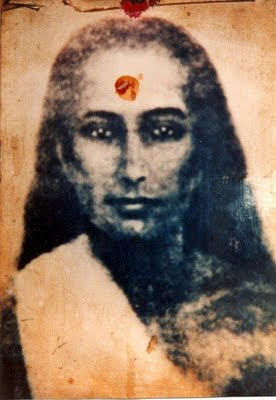
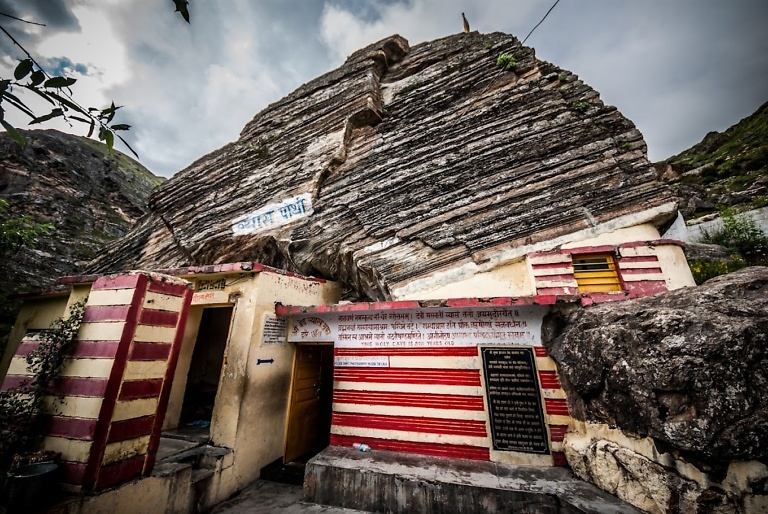
Badrinath, Land of Spirit
Badrinath is considered the most important of the four sites in India’s Char Dham pilgrimage, and gets its name from the temple of Badrinath. It’s unlike anywhere else in the world. The rugged pure beauty of the mountains and rivers alone makes this an unforgettable trip. It is one of the highest places in India accessible by road, and rests near the Tibetan/Chinese border. From here, giant glaciers form one source of the mighty and sacred Ganges River.
Much lore surrounds Badrinath: Paramhansa Yogananda said the immortal Mahavatar Babaji lives nearby to this day. Badrinath is mentioned in the ancient texts of India, and was re-established as a pilgrimage site in the ninth century by Adi Shankaracharya, the great reformer of Hinduism and founder of the Swami order. Legend also tells of the Pandavas of the Mahabharata making their divine ascension here.
We’ll visit the famous temple in the center of town, above the Ganges, which here is much smaller, and known as the Alaknanda River. The colorful Temple of Badrinath enshrines the sacred statue discovered in the river by Sri Shankaracharya in the 9th century. This statue depicts a seated, long-haired yogi, looking strikingly like Mahavatar Babaji. Hundreds of thousands of pilgrims each year seek spiritual blessings at this holy site.
We’ll drive a short distance to the village of Mana, just 15 miles from the border of Tibet. From here, amidst stunning natural beauty and clear air, ancient history becomes blended with still more ancient Hindu mythology. We’ll meditate in the cave where Ved Vyasa is said to have written the Mahabharata epic. Another cave is attributed to the elephant-headed Ganesha, said to have served as Vyasa’s scribe.
Close by, the characters of the Mahabharata come to life, as the “Stairway to Heaven” marks the path the Pandava brothers took at the end of their lives; Bhima’s bridge is the boulder he is said to have placed so his brothers could cross the Saraswati River. The Saraswati River is said to have its source from the mountain here, and flows above ground for only a short distance before going underground, only to emerge hundreds of miles later at Allahabad.
It’s just a 2-mile walk along the river from Mana to Badrinath. We’ll have dinners together at our hotel every evening in Badrinath.
While it’s still dark, we can walk to the temple and participate in the unique and moving early morning Abhishek puja, full of symbolism, led by Badrinath’s head priest.
After breakfast we can walk in the Neelkanth Valley, above the temple, where a number of sadhus and yogis live very simply. There is a special place on the river where departed souls are blessed and prayed for, and we can offer our own love and blessings at this spot. Free time in the afternoon can include bathing in the hot springs below the temple.
Those who wish can walk the “Stairway to Heaven” as far as Vasundhara Falls—a 3-mile hike. Free time can be spent exploring the town and hills at your own pace.
After an early breakfast we’ll start our drive down the mountain. An important stop will be the ancient town of Joshimath, where we can visit and meditate in Adi Shankaracharya’s cave, where he is said to have achieved enlightenment. Here, also, is one of the four monasteries he established in the four cardinal points of India.
Swami Kriyananda wrote, “I have always suspected that Paramhansa Yogananda was, in fact, himself Shankaracharya. Some of the stories he told me about that great master seemed to me the sort of thing history could not have recorded.”
Rishikesh, Gateway to the Himalayas
Rishikesh, land of the Rishis, is situated on the banks of the Ganges River. Saints and sages have frequented this sacred foothill locale for centuries.
Hundreds of ashrams and yoga and meditation centers populate this fascinating and picturesque area. Among the sacred places we will visit are the sites made holy by Swami Sivananda.
Swami Sivananda came to Rishikesh in the 1930’s and popularized meditation and yoga, making the town the “capital of yoga.” Our Rishikesh activities include meditation at Sivananda’s cottage on the Ganges River, his samadhi mandir, where his body is, and in the temple where “Hare Krishna, Hare Rama” has been chanted non-stop since 1942.
We can take a boat across the river, and at sunset participate in the Ganga Arati ceremony right on the water.
You’ll also have free time to spend by the river, to sightsee, shop in the markets, and walk along the pathways along the Ganges between the neighborhoods of Ram Jhula and Lakshman Jhula.
We’ll also visit the town of Haridwar, where the enormous Kumbha Mela gathering is held every 12 years.
Paramhansa Yogananda said, “If you go to a place where masters have lived, the vibrations there will quicken your realization.” In Haridwar, we’ll visit the ashram of Swami Keshabananda, where an outdoor temple houses the ashes of Lahiri Mahasaya. Then we’ll go to the ashram of Anandamayee Ma, immortalized in Autobiography of a Yogi, as the “Joy-Permeated Mother.” Her ashes are kept here in a special shrine, and the house where she lived is preserved.
About our hosts and our Ananda Delhi spiritual family
Spiritual Host for the Sept. 24 – Oct. 11, 2025 pilgrimage:
Nayaswami Krishna Das of Ananda Spiritual Travels with Ananda India Pilgrimage staff, and speciality guides.
Spiritual Host for the Sept. 28 – Oct. 15, 2025 pilgrimage:
Ananda Spiritual Travels and Ananda India Pilgrimage staff, and speciality guides
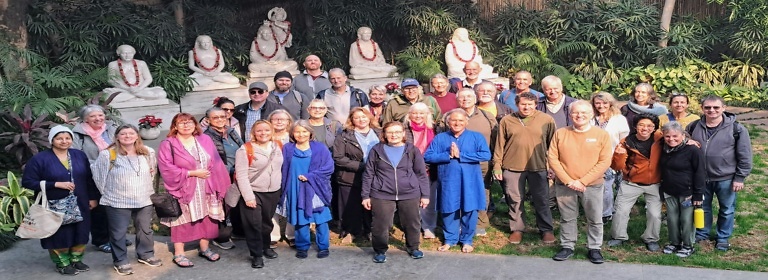
Ananda Delhi: Our heart’s home in India
The Ananda Delhi community will be our starting and end place on this pilgrimage. The first three nights we’ll stay at a nice hotel nearby the Ananda center, enjoy taking meals there, and time for sadhana. The Delhi staff and members are living reminders of Yogananda’s deep love of India, and they are spiritual ambassadors sharing the very best of Indian hospitality. Here you can begin to deepen your connection to Mother India, and feel her loving embrace.
Each pilgrimage will be hosted by a Spiritual Host, and an experienced team of co-hosts from Ananda Spiritual Travels and Ananda Pilgrimages of India. Our hosts are members of the Ananda Delhi and Ananda Village (California) ashram communities. As such, they are Kriya Yogis, practicing Kriya Yoga meditation daily as taught by Babaji Krishna to Lahiri Mahasaya. Kriya is the foundation of the Ananda Worldwide spiritual movement.
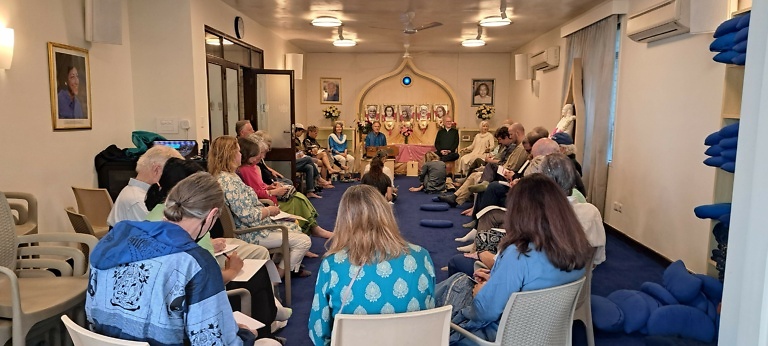
Himalayan Pilgrimage: Hosts and staffing
Each pilgrimage will have a team of 5 Ananda staff, with a Spiritual Host, Logistics Coordinator, staff and guest support person, leader for chanting and inspiration, and medical professional. Both pilgrimages will have staffing from Ananda Spiritual Travels, based out of California, and Ananda Pilgrimage India, based out of Delhi. In some locations we will also have specialty guides and long-time friends of Ananda who help us enter holy shrines with ease and joy for the highest best experience.
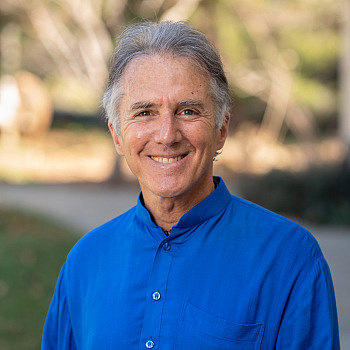
Nayaswami Krishna Das
Spiritual Pilgrimage Leader, Ananda Minister, Teacher, and Counselor
For the past 18 years, experienced pilgrimage leader, Nayaswami Krishnadas has taken people to holy places throughout India, Spain, Italy, Portugal, and the United States.
Krishnadas, a long-time Ananda teacher and minister, has an enthusiastic passion for sharing holy sites and the lives of saints. He helps you enter into the spiritual quality of each place so that you may have the fullest spiritual experience possible. He leads the group in the devotional practice of chanting, enhancing the trip with music and love for God. Krishnadas has lively and uplifting energy, and will make you feel at ease in foreign countries wherever you are.
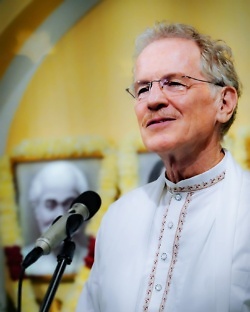
Keshava Taylor
Spiritual Co-Director of Ananda Delhi, Teacher, Spiritual Pilgrimage Leader
Experienced Pilgrimage leader and coordinator, Keshava has for 18 years regularly led Indian and Western pilgrims to spiritual power points around India. He continues to develop relationships with the custodians of these shrines. Keshava works with the tour operators, guides, hotels, and travel agents who are essential to making a trip comfortable and smoothly run.
Keshava’s attention to detail is phenomenal and his familiarity with India invaluable. He brings in-depth knowledge of Indian culture along with a deep understanding of spiritual teachings. His calm depth of spirit surrounds and encompasses each trip with a sense of solidarity and security that all will run well.
Himalayan Pilgrimage: 17-night program in India
Delhi, Haridwar, Badrinath, Rishikesh, Leh/Ladakh, Delhi
This schedule is the same for both of our Himalayan Pilgrimages, Sept. 24–Oct. 11th and Sept. 28–October 15, 2025.
For most guests flying from the U. S., you will depart 2 days prior to the first day of the pilgrimage, due to the length of your flight time and the time change.
Arrival Day in Delhi, is Sept. 24 or Sept. 28, depending on which pilgrimage you reserve. Guests must arrive on this day, at the latest. We highly recommend you arrive a day or two earlier to adjust to the time change and get your bearings. If you choose to arrive early, our Ananda India partners can reserve your extra nights at our group hotel, and you will pay for those upon arrival. If you fly into Delhi, you’ll be picked up at the airport and driven to our hotel.
Day 1: Delhi Orientation and Ananda Center
Our first full day starts with an uplifting opening gathering at the Ananda Delhi Center in the morning. A group lunch with afternoon excursion to get to know Delhi. Dinner at the Center.
Day 2: Get to know Delhi
Another day to relax into Indian culture, with visits to the Gandhi Smritti, Gurdwara Bangla Sahib, enjoy the colorful Khan Market, with lunch out. Dinner at Ananda Delhi Center.
Day 3: The blessings of Divine Mother
We’ll depart early and drive four hours by bus to Haridwar. Check-in, rest, and enjoy lunch at our hotel. A visit to the ashrams of Anandamoyee Ma and Swami Keshabananda in late afternoon.
Day 4: The blessings of Lord Shiva
Leaving Haridwar at an elevation of 1000 feet, we’ll start our bus journey ascending the mountains, driving most of the day, following the Ganges. Along the way, we plan to stop at Vashishta Guha, a large cave on the river, used by sages and yogis since ancient times. We’ll spend the night further upriver, near Rudraprayag. Named after Lord Shiva (Rudra), Rudraprayag is located at the confluence of the rivers Alaknanda and Mandakini and is venerated as one of the five sacred confluences or the ‘Panch Prayag’. Late arrival at our hotel with sadhana and dinner.
Day 5: On the road — Time for inner inspiration
Travel by bus from Rudraprayag to Badrinath, at an elevation of 10,000 feet. We’ll drive on curving high mountain roads, with steep canyons below, and spectacular lofty peaks above. We plan lunch along the way, and afternoon check into our hotel. First of four nights in Badrinath.
Day 6: Exploring Badrinath
A powerful place of pilgrimage since Vedic times, the Badrinath area is also said to be the present home of Mahavatar Babaji. Timeless peace and great spiritual power can be felt even in Badrinath’s rarefied air, pristine natural beauty, and soaring mountains.
“The northern Himalayan crags near Badrinarayan are still blessed by the living presence of Babaji, guru of Lahiri Mahasaya. The secluded master has retained his physical form for centuries, perhaps for millennia. Babaji’s spiritual state is beyond human comprehension.”
—Paramhansa Yogananda, Autobiography of a Yogi
Our first full day to enjoy Badrinath. A visit to the ancient village of Mana, including a walk along the Alakanand river back to Badrinath, and dinner at the hotel.
Beyond the village of Mana we’ll visit the cave of Ved Vyasa, where he’s said to have written the Mahabharata. A cave attributed to Ganesha is close by. We’ll cross the Saraswati River, in a rare appearance as it emerges from the mountain before going underground. We’ll cross “Bhima’s Bridge,” and walk the “Stairway to Heaven,” which the Pandhavas took at the end of their lives.
Day 8: Spiritual Activities in Badrinath
We will partake in the early morning Abhishek puja at the Badrinath temple.We’ll also walk in the Neelkanth Valley above Badrinath temple. An easy riverside walk boasts natural beauty, pilgrimage sites, and sadhus. A free afternoon for activities such as taking a ritual bath in the temple hot springs.
Day 9: A place for the Hindu heart
The day involves a drive downhill from Badrinath with an overnight stay near Rudraprayag. We plan to stop in Joshimath, and we hope to meditate in Adi Shankaracharya’s cave. The sacred town of Joshimath attracts a large number of Hindu pilgrims annually. The heart and sanctity of the town is the Jyotirmath or the Shankaracharya Monastery. According to Hindu mythology, Joshimath is one of the four maths, which were established by the Adi Guru Shankaracharya in the 8th century. Arrive around 5:00 p.m. to our hotel.
Day 10: Rudraprayag to Rishikesh
The journey continues from Rudraprayag to Rishikesh. We’ll stop at Devprayag and go down to where the two rivers meet, a place of tremendous spiritual power. Evening activities and dinner will be at our hotel in Rishikesh, located right beside the river.
Day 11: Holiness in Rishikesh
We’ll spend time at the Sivananda Kutir and Ashram. The Sivananda Kutir is situated on the banks of the holy river Ganga, providing a perfect natural setting for the practice of meditation.
The area, called Devbhumi, meaning the ‘Land of the Gods’, is renowned for its exceptional natural beauty and revered for its sacred heritage, with a vast history of spiritual practice going back thousands of years. Here sages and saints throughout the ages have found solace, peace and inspiration.
Day 12: An inner and outer day of transition day
An early morning drive from Rishikesh to our Delhi hotel. Ample time for lunch, resting, and preparing for our journey to Ladakh. An enjoyable dinner together.
Day 13: Fly high above the Himalayas
Early flight from Delhi to Leh in Ladakh.
Leh is at an elevation of 11,500. Arriving by flight requires a 12 to 24 hour acclimatization period to adjust to the elevation and thin air. We’ll spend our first day resting, drinking extra water, and having light, optional activities within the town of Leh. By taking this rest period, most people have little discomfort. You should consult your doctor if you have a chronic problem that could be affected by elevation. There is no need to walk long distances.
An extension of the Tibetan plateau, Ladakh is a separate world from the rest of India, yet just over an hour flight from Delhi. This is one of the most beautiful flights in the world, flying directly over the Himalayas. The spiritual heritage of Buddhist mystical teachings traveled from India to Ladakh, then to Tibet. They’ve been preserved and practiced uninterruptedly for the last 1,200 years. Ladakh’s continuous and still vibrant tradition of meditation, introspection and Dharma dates from this time.
We’ll meditate in temples and prayer halls—spiritual havens where Buddhist monks and nuns have meditated, prayed and chanted for centuries; and discover exquisitely detailed wall murals, thangkas (religious paintings), and sculptures, amazingly preserved by Ladakh’s rarefied air and dry climate. These old monasteries contain rich collections of paintings and artifacts and the tangible power left by centuries of spiritual masters meditating there. And we’ll dive deep into the silence of Divine Mother’s majestic nature.
Day 14: Monastery Visits in Ladakh [Day 2 in Ladakh]
Leh is one of Central Asia’s most scenic towns, tranquil, historic, the capital of Ladakh, and long an important stopover on the old Silk Road connecting China, India, and Europe. Our hotel in Leh is within walking distance of the main bazaar—a mixture of Tibetan and Kashmiri curio shops, trekking provision stores, street vendors, and restaurants.
With our Buddhist Ladakhi guide, we’ll experience morning prayers at Tikse monastery, and visit the Tikse, Hemis, and Stakna monasteries. In Hemis monastery—one of Ladakh’s richest and most renowned—we’ll meditate where some say Jesus studied during his “lost years.”
Day 15: Alchi [Day 3 in Ladakh]
We’ll drive along the Indus River downstream to the charming ancient village of Alchi, containing deeply peaceful 11th-century temples with wall paintings done in Kashmiri style. Dinner back at the hotel in Leh.
Day 16: Leaving Leh, Returning to Delhi
We’ll fly back to Delhi, enjoy lunch at Ananda Delhi Ashram, and celebrate together with an afternoon closing ceremony. Dinner at ashram. Final night in Delhi.
Day 17: Go with Love!
Hotel breakfast is included this morning. You may leave early this moring, or get a full night’s sleep, departing later in the day. If you want to stay extra nights at our Delhi hotel we can arrange that for you and you will pay us when you arrive for the pilgrimage. Typically, $130 per night in our nice hotel.
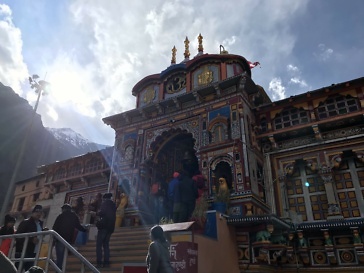
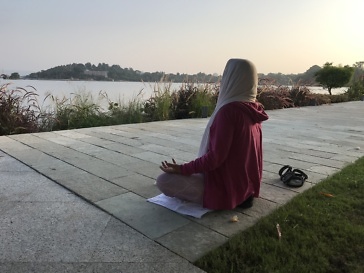
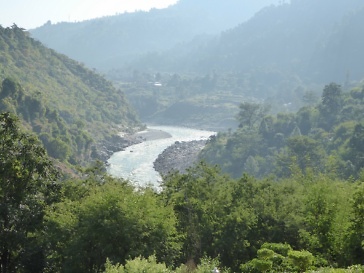
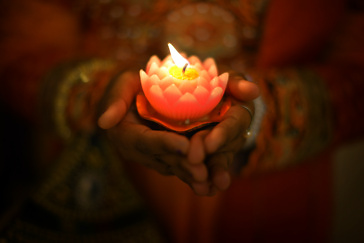
Stay connected: Be the first to learn the finalized dates and pricing
| Dates |
Sept. 24 – Oct. 12, 2025 Sept. 28 – Oct. 16, 2025 |
| Duration | 17 nights, 16 days. Each pilgrimage has the exact same itinerary. |
| Location | India: Delhi, Haridwar, Rudraprayag, Badrinath, Leh/Ladakh, and Rishikesh |
| Leaders | Four expert hosts from Ananda Spiritual Travels and Ananda Pilgrimages India |
Costs
Early Bird Rates
Available now through Feb. 15, 2024
Shared room, per person*: $2,500
Private room: $3,300
Regular Rates
Available from Feb. 16 – June 15, 2024
Shared room, per person*: $3,000
Private room: $4,000
*We will match you with a roommate of the same gender.
To register, reserve online and make your $1000 U.S. deposit — this will secure your reservation. Remember, space is limited!
Sign Up to Stay Connected
We’re currently finalizing the dates and details for this pilgrimage. Would you like to know more? Just add your email to this list and we’ll keep you up to date.
Important Details
You should be moderately fit, without health conditions liable to be affected by elevations up to 11,500 feet. All destinations involve climbing many stairs, at your own pace. Extensive walking is not required. Longer hikes are optional. See the “About High Altitude” section below.
Your own meditation practice will enhance the pilgrimage experience, but is not necessary to deeply enjoy this trip. A love of adventure, high mountains, natural beauty, ancient cultures, spiritual traditions, and silence is all that is needed. Optional group meditations are offered most days.
Traveling in the high mountains one must expect the unexpected, and flexibility is a key item to pack in your suitcase. Daytime weather is usually mild, but can also change suddenly. Roads are occasionally blocked by falling rock, which may cause delay or change of plans.
You should be moderately fit, without health conditions liable to be affected by elevations up to 11,500 feet. All destinations involve climbing many stairs, at your own pace. Visiting monasteries involves climbing many stairs. Those with asthma or heart conditions should consult a doctor and may need to limit their activity. This is not a suitable trip for those of fragile health.
Extensive walking is not required. Longer hikes are optional.
Leh is at an elevation of 11,500 feet. Arriving by flight requires a 12- to 24-hour acclimatization period to adjust to the elevation and thin air. We’ll spend our first day resting, drinking extra water, and having light, optional activity within the town of Leh. By taking this rest period, most people have little discomfort. You should consult your doctor if you have a chronic problem that could be affected by elevation. There is no need to walk long distances, but both Ladakh and Badrinath involve climbing many stairs. Those with asthma, diabetes, blood pressure, lung or heart conditions should consult their doctors and may need to limit their activity. You may choose to arrive in India a day or two earlier than the group if you would like extra time to rest and get over jetlag, before ascending to this elevation. This would cost just $100-150 per day extra. Badrinath is only slightly lower than Ladakh, at 10,000 feet, but we make our ascent gradually by road. Also in Badrinath, hiking is optional, and you can have a thoroughly enjoyable time without long walks.
Arrival Day in Delhi, is Sept. 24 or Sept. 28, depending on which pilgrimage you reserve. Guests must arrive on this day, at the latest. We highly recommend you arrive a day or two earlier to adjust to the time change and get your bearings.
If you choose to arrive early, our Ananda India partners can reserve your extra nights at our group hotel, and you will pay for those upon arrival. If you fly into Delhi, you’ll be picked up at the airport and driven to our hotel.
All hotels, restaurants, and menus have been personally inspected by Ananda. We’ll stay in clean, Western-style, comfortable but not luxurious 2- or 3-star hotel rooms with attached bath, and central heating where needed. In the mountains the variety of fruits and vegetables is limited. Still, hotel buffet meals include simple but healthy Indian, Western, and Asian dishes.
In-country transportation:
We’ll fly from Delhi to Leh (capital of Ladakh), about 1 hour each way. Transportation within Ladakh will be by air-conditioned bus or SUV, on good roads, driving 2 – 4 hours a day for two days.
Transportation up to Badrinath includes air-conditioned train the first afternoon, followed by 12 – 14 hours of driving by air-conditioned SUV, spread over two days. The road to Badrinath is spectacularly scenic, but often curving. Washouts during the monsoon season are never fully repaired, making the road paved for most of the distance, but also with long gravel stretches, sometimes in poor condition. Our drivers are well-experienced with these roads, and we’ll have a very experienced local guide we have worked with for almost 30 years of Ananda Himalayan pilgrimages, but this is definitely a mountain adventure.
We’ll fly from Delhi to Leh (capital of Ladakh), about 1 hour each way. Transportation within Ladakh will be by air-conditioned bus or SUV, on good roads, driving 2 – 4 hours a day for two days.
Transportation up to Badrinath includes about 4 hours driving in an air-conditioned chartered bus the first day. This is followed by our climb up the mountains: 12 – 14 hours of driving by bus, spread over two days. We rise in elevation from 1000 to 10,000 feet. The bus is air-conditioned only at low elevations. As we rise in elevation, windows can be opened.
The road to Badrinath is spectacularly scenic, but not always smooth, and often curving, with switchbacks. Washouts during the monsoon season are never fully repaired, making the road paved for most of the distance, but also with long gravel stretches, sometimes in poor condition. Our drivers are well-experienced with these roads, and we’ll have a very experienced local guide we have worked with for 30 years of Ananda Himalayan pilgrimages, but this is definitely a mountain adventure.
Proof of Travel Insurance is required. We will provide you an outline of what your travel insurance should include such as the price you pay for the pilgrimage, your flights, and medical coverage. This can range from $250 up to $600 depending on how in depth your coverage is.
You will need a passport that is valid for at least 6 months from the intended arrival date in India, and two blank pages. If you need a new passport, or need to renew one, do so immediately by going to travel.state.gov. You will find instructions there. You will need a valid passport in order to apply for an e-Visa.
Tourists may apply for Indian tourist visa anytime for 30 days, 1 Year or 5 Year and arrive at a selected Indian airport and their continuous stay during each visit shall not exceed 30 or 90 days for countries except USA, UK, Canada and Japan.
For citizens of the USA, UK, Canada and Japan continuous stay during each visit shall not exceed 180 days from the date of entry in India. We will provide you information about the best ways to get a VISA, which should be done closer to the time of your departure.
Frequent questions
What is your cancellation policy?
For cancellations received before Feb. 15, 2024, your payment will be refunded, less a $150 cancellation fee.
For cancellations received before June 15, 2024, we will provide a 50% refund.
For cancellations made between June 15 through July 15, 2024 we will refund $150.00.
Can I choose a shared room if I don’t have a roommate?
Yes. If you prefer shared lodgings but are not coming with a roommate, we will try to match you with someone of the same gender who also needs a roommate.
When will full payment be charged?
Full payment will be charged to your credit card on the last day of the Early Bird or Regular pricing dates.
Any questions?
For more information, or to talk further about this pilgrimage, please write to us. We’d love to answer any questions that you have.
"*" indicates required fields
“The northern Himalayan crags near Badrinarayan are still blessed by the living presence of Mahavatar Babaji…” The artwork below, a depiction of a devotee with the Masters in the Himalayas, is by Jonah West. Visit his website at Jonah West Art.